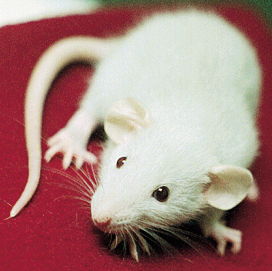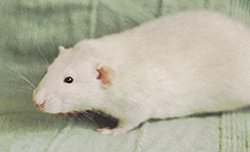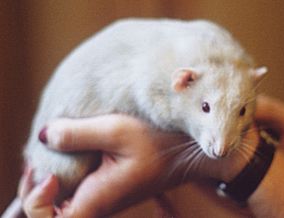|
Many shades make Platinum, a colour of rat which can vary from a bluish-ivory to a subtle ice-blue, with red or ruby eyes. Each shade depends on how it is made genetically and, like the Blue gene described above which is fundamental to its makeup, there is a wide variation. There is also a corresponding range of dilutions in the Russian Blue. The Platinum is a very new addition to colours in the UK, and is making an impression as well as causing a lot of confusion. Note: The genetics information given in this article represents work in progress and may change over time. Last updated December 1st. 2002. |
|
|
It is as well to start discussing the colour by describing the Platinums which are bred in the UK. The colour arrived in July 2000, when two Platinum Agouti Dumbo bucks were imported from Belgium, one owned by Lucie Mann, the other by Marion Benham. The bucks, littermates, were out of a Cinnamon doe from pure USA lines (River Rats), by a mink blazed odd-eyed buck whose parents - American Lilac and American Blue - were also USA imports. As kittens they
were a very pale champagne colour with a distinct bluish undertone,
and red eyes. As they moulted out, it became obvious they were agouti-based
Platinum, and finished up a delicate rich cream ticked with pale
silver, and a subtle overall ice-blue tone. Another Platinum from
the same litter stayed in Europe and developed into a non-agouti
Platinum, which is best described as a smooth light silver colour
with the same subtle bluish tone.
|
|
|
Platinum Standards Platinum is standardised by the major clubs in the USA, however it seems that not all the different genotypes of Platinum would meet the standards for show, and that different clubs ask for different shades. RMCA describes it as an even
dove grey shade with no blue, and eyes ruby to dark ruby. In Europe, there are several different
shades of Platinum bred, some described as "verbleekt" [=bleached,
diluted]. Many of these have a pronounced ivory tint, but it
is uncertain which Platinum genotype these are.
|
AS AN ADULT |
|
Platinum Genetics There is noPlatinum gene. Platinum is a colour made by the combination and interaction of at least two, sometimes three, different genes. Claims by breeders that rats "carry Platinum" are inaccurate, as several different genes need to be present on both sides to produce the colour. A rat cannot carry Platinum, but it can carry any or all the genes necessary to produce it, providing it is bred to the right rat. Novice breeders owning Platinums are strongly advised to seek genetic advice before breeding their rats. A great deal will depend on the pedigree and genetic ancestry of their rat/s, and compatibility of the proposed mates. Platinum is a double recessive, some forms are triple-recessive. Unless all the right genes are present on both sides, no Platinums can result. |
|
|
The first Platinums in the UK were originally thought to be American Blue combined with the Ruby-eye (aka Red-eye) gene r, since this is claimed to be a fairly common genotype of Platinums in Europe and the USA. But when Marion bred her buck to a Topaz doe A-rr, she was surprised get a whole litter of Agoutis. It was then theorised that they may be Mink/Blue based Platinums. Study of the pedigree and advice from breeders of Platinums appeared to bear out this theory. Marion then bred her Platinum Agouti to his litter-sister, a Cinnamon, and produced Platinum Agoutis and Cinnamons, so it would appear this genotype may be the correct one. However, it was noticed that the Cinnamons in this litter were an unusual, dull bluish shade. More recent investigation has shown that a previously unknown colour, similar to Mink, is one of the colours that make up the Platinum in the UK and Europe. This colour was carried by Dumbo and Russian Blue imports, of American lines, to the UK from Europe, and test-mating with Minks in the UK has shown it to be genetically unrelated. At time of writing [Winter 2002] this mystery colour - which closely resembles Mink and will also combine with pearl - is referred to by UK breeders as "Mock Mink". "Mock Mink"combined with
American Blue is but one variation of Platinum. 1. American Blue diluted by Ruby-eye
aarrgg It is claimed that the darkest of these is the Chocolate/Blue combination, dubbed "Sterling Silver" platinum. One of the paradoxes about the Platinum colour is that breeders in the UK don't produce a Platinum colour when combining English Blue with Mink. Mink-Blues, as they are sometimes called, could loosely be described as "blue with a hint of mink" - neither one nor the other, but at first glance, more blue than mink - on closer inspection, more mink than blue. In the early 1990's Roy Robinson bred some rats which he claimed were a combination of mink and blue, and described them as a light silver blue colour instead of the usual dark slate blue. The undercolour was said to be light or white, varying in intensity and creating the silvery effect. He proposed they should be called "silver blues" but the variety did not gain any popularity and disappeared.It is possible that these rats may have been silvered mink-blue combinations, or possible even Blue Pearl. |
|
SourcesPro-Rat-A #63, May/June 1991 "Birth of the Blues" by Joan Branton
Pro-Rat-A #73, Jan/Feb 1993 "The Silver Blue" by Roy Robinson
Personal correspondence, Ann Storey, NFRS
Personal correspondence, Karen Robbins, AFRMA
AFRMA Newsletter Vol.16 No.3 "Russian Blue Rats" by Nichole Royer
AFRMA Newsletter Vol.16 No.3 "Colours & Coats" by Nichole Royer
Genetics section, http://www.rodentfancy.com (Myomorpha)
RMFE website, http://www.rodentfancy.com
AFRMA website, http://www.afrma.org
RMCA website, http://www.rmca.orgOther Contributors
Marion Benham, Chris Casteels, Lucie Mann, Estelle Sandford, Carine Vereecke.
ALL PARTS OF THIS ARTICLE INCLUDING TEXT AND IMAGES STRICT COPYRIGHT © SUE BROWN 2001/2002
NO PART OF THIS ARTICLE MAY BE COPIED OR REPRODUCED WITHOUT PRIOR PERMISSION OF THE AUTHOR.
ALL RIGHTS RESERVED.


